|
Inventive Genius in Electrical Engineering: ECC of Wolverhampton
Electric lighting was the wonder of the 1880s.
In a land dependent upon shimmering candles or dim gas flames to
cast a fluttering, hazy light over a small space, the ability of arc
lights to brightly illuminate a large area was astounding. And a
Wolverhampton firm was in the forefront of this technological
breakthrough. It was Elwell-Parker of Commercial Road which would
develop into one the most important manufacturing concerns in the
town - the Electric Construction Company. That it did so owed much
to the inventive genius of Thomas Parker, one of its partners. |
|

Thomas Parker in middle age. Courtesy of
Gail Tudor. |
In June 1888, a Manchester newspaper reported that "electric
lighting is rapidly establishing itself as a valuable
illuminating example". This had been made clear the previous
evening at the Royal Botanical Gardens in Old Trafford where the
great improvements which had been made "were shown by what was
undoubtedly a fine display of electric arc lighting", which lit
up the whole of the grounds. A total of 56 arc lamps had been
supplied by Edison and Swan, the business set up just five years
before by the pioneering and inventive Thomas Edison of the USA
and Joseph Swan of England. However the dynamos had been
especially made by Elwell-Parker. There were two machines which
were "shunt wound', each of which was capable of working 40 arc
lamps. Slow-speed machines, they ran at 700 revolutions per
minute.
It was a notable achievement for a company that had only been
founded in 1884 but it was one of a number of remarkable
successes. |
|
In January 1886 it was reported that 380
incandescent lamps had been installed throughout the Swan Garden
Ironworks of Messrs John Lysaght in Wolverhampton. The current
for them was generated by two Elwell-Parker dynamos which were
driven at 95 revolutions per minute by an ordinary high pressure
horizontal engine. A pair of similar dynamos had also been
supplied to the Monmore Ironworks of E. T. Wright and Sons and
at George Wilkinson's Sheet Mill at Tividale.
By now, Elwell-Parker had laid down the
electrical plant for the Blackpool Tramway, one of the earliest
examples of electric traction in the world. Then in late 1888,
and at the behest of Birmingham Corporation and the Birmingham
Tramway Company, the Wolverhampton firm played a crucial role in
the trials of an electric motor for tramcar propulsion in
Birmingham. The motor was made by Elwell Parker under a patent
from a Belgian company, but the necessary dynamo machine and
accumulators were manufactured according to the firm's own
patents. These trials led to the construction of the Birmingham
and Bournbrook Electric Tramway. |
|
Earlier that year the Wolverhampton
business had received a large order for dynamos, exciters,
secondary generators, regulators, metres, and other equipment
from a new company in South Kensington that aimed to replace gas
lighting with that of electric.
It was explained in a Sheffield newspaper
that the orders were valued at many thousands of pounds and that
other orders were expected quickly. Indeed "the works are very
busy, running day and night". |
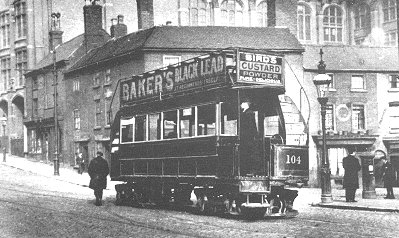
One of the accumulator-powered Birmingham
trams. |
|
The rapid growth of Elwell-Parker arose
from its innovative and quality products arising from the mind
of the extraordinary Thomas Parker. The son of a moulder in
Coalbrookdale, he had been nine when he had started work at the
foundry where his father was employed. He later recalled that he
arrived at 5.30 in the morning "to light the fires, and so
prepare for the men. Sixty hours and more was the week's work .
. . Life was hard at the works. If a boy did not quickly do what
was ordered, he would often receive a kicking from his
superior."
From an early age, though, Thomas Parker
was determined to educate himself by attending evening classes,
whilst he also showed an aptitude for making things. After
becoming a moulder, he went to work in Birmingham. The
embodiment of a self-improving working-class man, he attended
the Church of the Saviour of the acclaimed preacher George
Dawson and went to lectures at the Birmingham and Midland
Institute.
Following his marriage to his wife, Jane,
and like many another highly-skilled men, Thomas tramped the
country seeking better employment opportunities. After a time in
the Potteries, he went to Manchester, where he also attended
science lectures at Hulme Town Hall. These were to have a
positive impact on his life. Thence he went to Dudley and
finally in 1867 he returned to Abraham Darby's Works at
Coalbrookdale as a foreman in the engineering section.
Now aged 24, he was rapidly promoted to
take charge of the chemical department and electro-depositing.
According to a local newspaper it was here that "his faculty for
invention asserted itself". In 1877 he and Philip Weston, a
machinist at Coalbrookdale, patented improvements in direct
acting steam pumps and steam engines - for which they were later
awarded a medal at the Inventions Exhibition. |
|
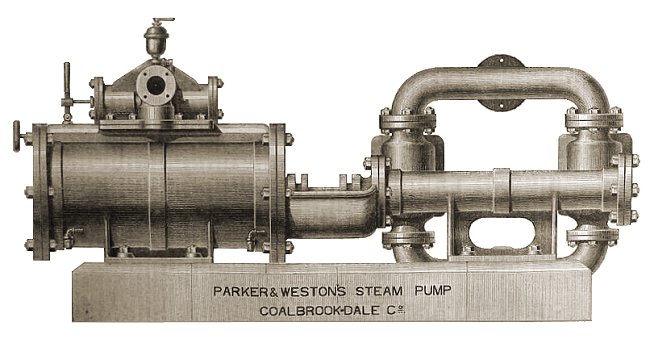
A Parker and Weston steam pump. |
|
Two years later, Thomas designed and built
a dynamo for the electro-plating department at Coalbrookdale and
he went on to invent the open Kyrle grate and the Robinson gas
engine for Tangye's of Smethwick. But henceforth it was
electricity which gained the attention of his quick and talented
mind. By 1882 Thomas was on the management of the engineering
portion of the foundry and that year he gave a lecture in which
he demonstrated Edison incandescent lamps. The source for the
current was secondary batteries made by Parker. In their
manufacture he had "discovered and utilised the important point
of the great value of concentrated nitric acid in facilitating
the formation of the necessary oxide". He applied for a patent
for this discovery at the same time as Garton Plante and the
patent was divided between them.
That year, Parker also became involved with
Paul Bedford Elwell of the Patent Tip and Horseshoe Company in
Commercial Road, Wolverhampton and next to the Crown Nail
Company. Elwell had been educated at King's College, London,
where he had obtained a distinction in mathematics, and he had
studied coal mining and iron manufacturing in northern France.
He also had an inventive bent and had taken out patents for
venetian blinds and nail making machinery. Together Elwell and
Parker patented an improved lead-acid accumulator and
improvements in dynamos and electric lighting apparatus.
At the end of 1882, Parker moved to
Wolverhampton and the two men joined forces. With 100 people
working in Elwell's operation making nails and horseshoes,
Parker started his side of things with one of his sons and one
man. At first they built accumulators but early the next year
they made a dynamo. Parker himself thought it was a 'waster',
but it was bought by a representative of the Edison and Swan
Company of Manchester who had visited the works. After some
attention on site by Parker, it was successful in coating calico
printing rollers with nickel.
The inventor remembered that he received a
£40 and a testimonial. He was encouraged to build a dynamo for
lighting, and "this was a success, and got us an order for six.
We received from the Manchester Edison Company of that time,
£1,000 in advance for building dynamos: this was the beginning
of Elwell-Parker, and of dynamo manufacturing at Wolverhampton."
This business developed rapidly and in
December 1884 the company of Elwell-Parker Ltd was formed with a
capital of £50,000. Interestingly the move gained more attention
in the Manchester newspapers. This was because of the connection
with Edison and Swan and because all seven subscribers were
Manchester men. |
|
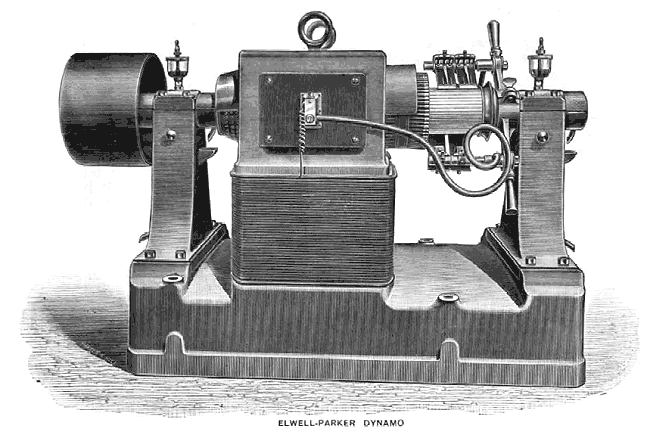
From 'The Engineer'. |
|
Parker was now gaining considerable notice
and acclaim. In 1885 he was made a member of the Institution of
Electrical Engineers and was praised in the Royal Society of
Arts Journal for leading the way in developing the electricity
industry in Britain. His ingenuity was highlighted two years
later when he developed a cheaper process to extract phosphorus
and chlorate of soda by electrolysis.
By now, Paul Bedford Elwell had left for
Paris to prepare plans for its underground electric railway but
Parker continued to direct the growth of the Wolverhampton
company. In 1889 he was made a member of the Institute of Civil
Engineers, whilst Elwell-Parker Ltd, which now employed 400
people, was taken over by the Electric Construction Corporation
Ltd. Parker was appointed engineer and manager and under his
supervision an impressive new factory at Bushbury was designed,
laid out and constructed. This included a large electrical
'Erecting Shop' which housed two tracks running 30 ton cranes.
Parker went on to direct numerous "very
large installations in connection with electric traction,
including the Liverpool Overhead Railway and the overhead system
of the electric traction in South Staffordshire". The
installation of electrical lighting in Oxford was also designed
by Parker and this 'Oxford System' was adopted by other towns.
In 1894, Parker ended his association with
the ECC and set up Thomas Parker Ltd to manufacturing plant for
electric lighting, electric transmission of power, electric
railways, electric tramways, and electro-chemical and
electro-metallurgical purposes amongst other things. The three
other directors were Charles Tertius Mander, the Mayor of
Wolverhampton; Thomas Graham, the proprietor of the 'Express &
Star'; and William Thomas, a manufacturer. |
|
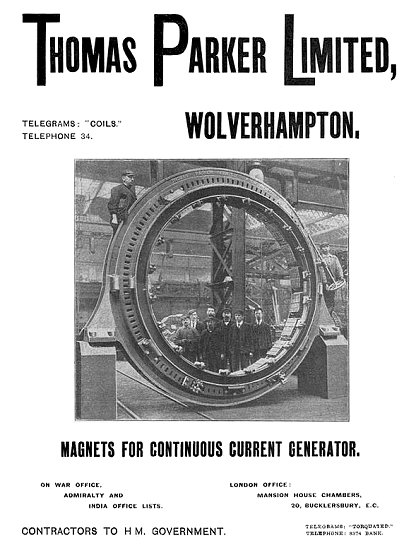
A 1905 advert from 'The Electrical
Review'. |
Production was at a new works on the
Wednesfield Road. The company was awarded a gold medal for
high-speed railway motors at the International Exhibition in
Brussels in 1897.
That year Parker's initiative led to the
formation of the Midland Electric Corporation to distribute
electricity in South Staffordshire. It was the first company to
get statutory powers to distribute electricity over such a wide
area. A power station was built at Ocker Hill with sub-stations
at Bilston, Brierley Hill, Darlaston, Old Hill, Tipton and
Wednesbury.
In 1899 Parker stepped down as managing
director of Thomas Parker Ltd. However, he remained on the board
and as consulting engineer until 1904 when he moved to London,
where he was consulting engineer to the Metropolitan Railway
Company. As such he was responsible for the design and
construction of its first electric engine.
When he died in December 1915, Thomas
Parker was acclaimed as a pioneer of electrical railways and as
one of those responsible for the progress made in electrical
science in the latter part of the nineteenth century. |
|
As for the Wolverhampton companies with
which he had been associated, unfortunately it seemed that there
was not enough business nationally for two large electrical
engineering firms to prosper in one town and in 1909 Thomas
Parker Ltd was wound up.
The Electric Construction Corporation had
also struggled after a bright start. In 1893 it too had been
wound up, but fortunately it was reconstituted as the Electric
Construction Company. It then prospered. During the 1930s and
40s its main production was in rotating electrical machinery,
switch and control gear, static transformers, and rectifiers;
and by the 1960s it was also manufacturing and installing many
of the power station generator systems in the UK.
By this decade the firm boasted several
factories in Wolverhampton and abroad. Locally, a control gear
factory had been built at Shaw Road, by the main works; whilst
the associate companies of E.C.C. Moulded Breakers Limited and
Federal Electric Limited had been set up in Fordhouse Road,
Bushbury. These made a complete range of medium voltage
switchgear for use in electrical distribution in industry,
hospitals, shops and houses. |
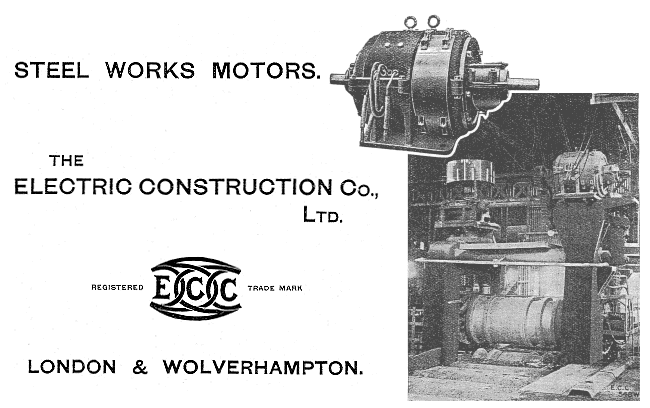 |
|
In the late 1970s a policy decision was
made to concentrate all the production effort onto the range of
Brushless A.C. Generators and the 'Automatic Voltage Regulation'
system. These generators were produced in large quantity and
supplied worldwide to diesel set manufacturers such as Lister,
Blackstones, and Petter but in 1983, despite efforts to redesign
the machine, which unfortunately lacked capitalisation, cost
effective competition began eating into the market.
Employing about 2,300 people at its peak,
E.C.C. was of massive importance to the economic well-being of
Wolverhampton, but by the end of the 1960s it was beginning to
face problems. In particular, cheaper foreign products, some of
them subsidised by governments, had an adverse effect upon
sales. These problems mounted and sadly the E.C.C. factory at
Showell Road, Bushbury was closed in 1985 and 800 people lost
their livelihoods. It is a pity that today, too few realise the
importance of this site and of Wolverhampton to the emergence
and development of electrical engineering.
However the company lives on through former
employees who meet at the 'ECC Social Club' in Showell Road,
Bushbury. Since 1985 a well-supported reunion has been held each
October, bringing together old friends and companions. Details
are available via tetlow620@btinternet.com or rogben@blueyonder.co.uk |
 |
|
 |
|
 |
Return to
Commemoration |
|
Return to the
beginning |
|
Proceed to
T. H. Parker |
|
|